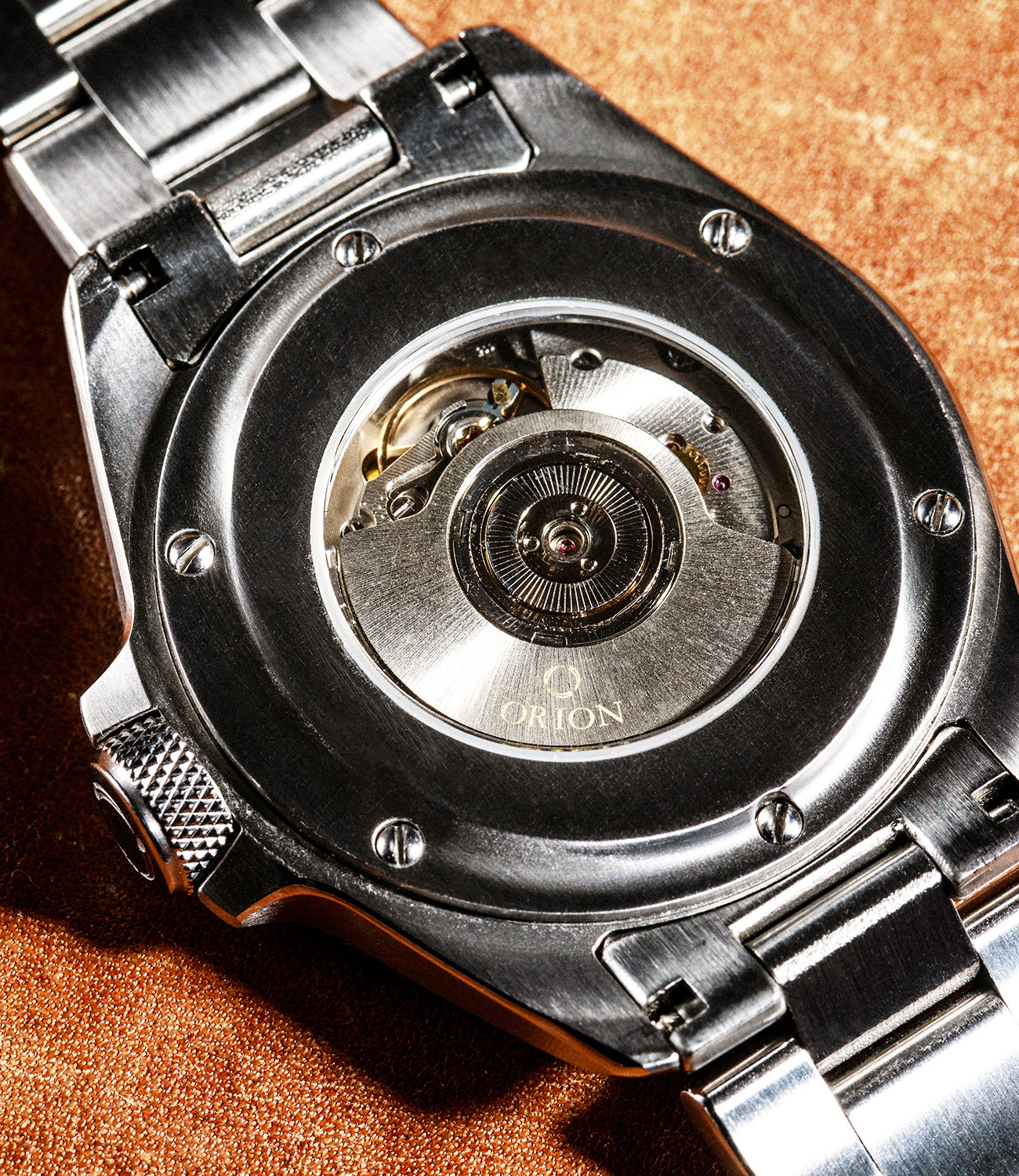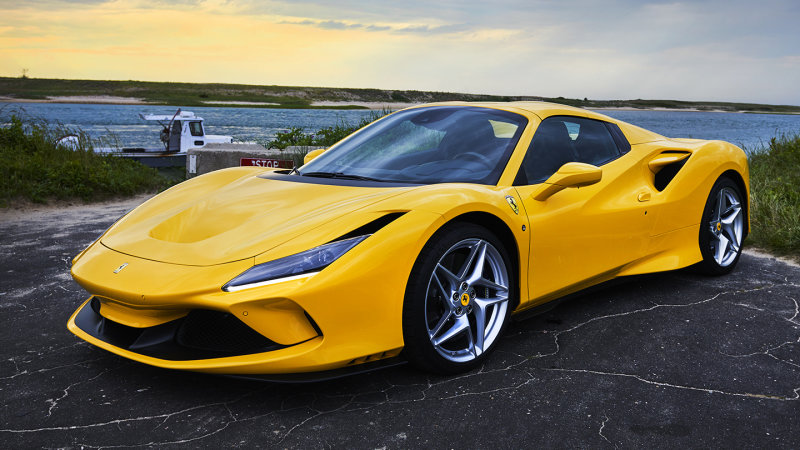Nick Harris has gone far in what feels like a short amount of time. It wasn’t so long ago that he first made a name for himself modifying one-off Seikos for customers in his bedroom; now he’s finishing up a two-year stint in one of America’s few watchmaking schools. To pay his way through the program, Harris took his craft to the next level, creating Orion Watches and his first from-the-ground-up design. Now, with graduation looming, and with a desire to revive a lost industry of American watchmaking (which is no small feat), Harris has launched a new model, the Calamity, a dive timepiece as ambitious as his aspirations are.
“The Calamity is a much more serious watch. I pushed my manufacturer to up all the tolerances and quality, and I’m using a Swiss movement,” Harris tells me over the phone. “All that manufacturing I need to do is very expensive. The first Orion’s goal was to get me through school — and it did that — but the Calamity is the watch that will fund [the next phase].”
The Good: The Calamity is a watch that puts fit and finish above all else. This ethos manifests itself mostly in the case which, in addition to featuring some excellent finishing, is sculpted and designed to be thin, detailed and comfortable. This means that it looks refined in a way many dive watches don’t, and it feels great to wear, too. There’s more to the Calamity than the well-designed case (a quality movement from ETA and a ceramic bezel insert are other highlights), but it’s by far the thing that makes it stand out most and reason enough to consider it over a dive watch from an established brand.
Who They’re For: Somebody willing to take a chance on — let’s be honest here — an unknown brand if they favor detail, comfort and refinement over brand recognition. The Calamity is not a cheap watch, especially in the realm of micro-brands, but that doesn’t mean that it isn’t worth the price. It just means that it’ll have the most appeal to a very detail-oriented buyer.
Watch Out For: The Calamity is, for the most part, a solid watch, but there are a couple of small quibbles worth noting. For one, this watch doesn’t feature a date window on the dial (no doubt to appeal to the enthusiast crowd) but the movement inside retains its date wheel. This means that when you pull the crown out to set the time there’s still a secondary crown position for setting the date. It’s a small qualm, but a qualm nonetheless. Some reviewers have also criticized the bracelet clasp for feeling somewhat sub-par. I can kind of see where they’re coming from, but it’s a small point of contention and hardly a deal-breaker.
Alternatives: There are, quite frankly, many different routes you could go here, but I’ll name two. In the boutique brand camp, you have Christopher Ward and the recent C65 Trident Diver which is cheaper ($795) and similarly thin at about 11.5mm high, though it uses a hand-winding movement from Sellita. You also give up 50 meters of water resistance, though this is probably not a problem for most buyers. The Oris Divers Sixty-Five is another great option if you want something from an established watchmaker, but it costs a few hundred more than the Calamity, and you’re only getting 100 meters of water resistance and a profile that’s not quite as slim.
Review: Slip the Calamity over your hand and on to your wrist, and you notice that it’s thin. Very thin. And not just thin for a dive watch, but thin for an automatic watch, period. At its highest point the Calamity is 11.2mm, but if the watch’s sapphire crystal weren’t domed, it’d be merely 9.5mm, according to Harris. As he sees it, this is a sort of innovation in and of itself. “Dive watches today are very bulky and huge, and while they can look great top-down or head-on, when it comes to wearing them they’re slab-sided,” he says. “I also think it’s a crutch. It’s easy to get a lot of water resistance out of [something thick], but making a thin watch with a lot of water resistance? That’s hard to do.”

There’s more to the case than that, however, and Harris was able to pack it full of tons of detailing work. For one, it features polished beveled edges that flow along the entire side of the case, top to bottom, while the crown guards at three o’clock taper to a point, showcasing more of the crown’s knurled texture and making it easy to grab. The lugs are slender and have a gentle downward curvature, contributing to an elegant design. More interestingly, the transparent case back is curved to better align with the wrist of the wearer. The effect is a watch that sits very flat and comfortably on the wrist, and given that the Calamity is a light watch to begin with, the whole thing feels suspended, almost weightless.
On the surface, the rest of the watch feels like it borrows much from dive watch design tropes, but there’s a reasoning behind each element. The hour indices, for example, are thicker versions of the ones you’ll see on the first Orion watch, merely made larger to accommodate more lume. The second hand? A lance-like design, inspired by Harris’s vintage Omega Admiralty. The marker at twelve o’clock on the bezel (which is made from ceramic, by the way) is a rounded chevron design, inspired by, but not meant to imitate, the triangle you’ll find on many divers.
The watch is available in black, blue and the pictured green, which Harris said wasn’t originally supposed to be on offer. “Some of the curves and angles of the case kind of reminded me of Master Chief and his armor, and his aesthetic, and I just sort of had that in my head,” Harris says. “When we were designing them, we were playing with colors, and I said ‘I want to do this in green, like the drabbest green.’ We ended up doing a couple of different ones, and it turned out fantastic.”
To achieve such a thin case, Harris had to upgrade to a higher-end movement than he’s used to working with, an ETA 2892, a slimmer, more refined counterpart to the ubiquitous ETA 2824-2. Harris explains the higher cost of the watch is a result of the movement upgrade, but without it, his vision wouldn’t have come to light. And while he understand that some people might take issue with the price, he know’s he’s justified in asking for it. “It’s a very expensive movement. It’s got a very elaborate case shape. To get a watch that’s functional to those specs, that’s not cheap,” Harris explains. “Most people critically compare it downwards, to cheaper watches. People who compare it to watches in the same price point, you can see where it can hang in the ring with those guys.”
Verdict: I’ll agree with Harris on this one. We do these sort of mental gymnastics and exhaustive justifications when it comes to expensive watch purchases constantly. And much of the time, we have an established brand name to fall back on. The Calamity doesn’t have that convenience, but the fact that it doesn’t need it is further proof that microbrands like Orion can build a captivating product, even at a higher price point.
What Others Are Saying:
• “There’s no arguing that the $1,495 asking price might be considered a barrier to entry for a fairly young brand without the track record to prove they can compete happily alongside more well-established names. However, it’s also clear that this is a well-designed and executed watch.” — Brad Homes, Worn & Wound
• “I find it very impressive to see this watch take things to the next level in today’s saturated microbrand world. To witness so many “cash grab” micros pop in and out of the scene is really disheartening…a product like the Calamity is refreshing and potential buyers will also quickly realize the dedication Nick puts into his designs and every aspect of his business.” — Michael Pinate, A Blog to Watch
Key Specs
Movement: ETA 2892-A2
Winding: Automatic
Case diameter: 40mm
Case thickness: 11.2mm
Water resistance: 200m
Hot takes and in-depth reviews on noteworthy, relevant and interesting products. Read the Story





